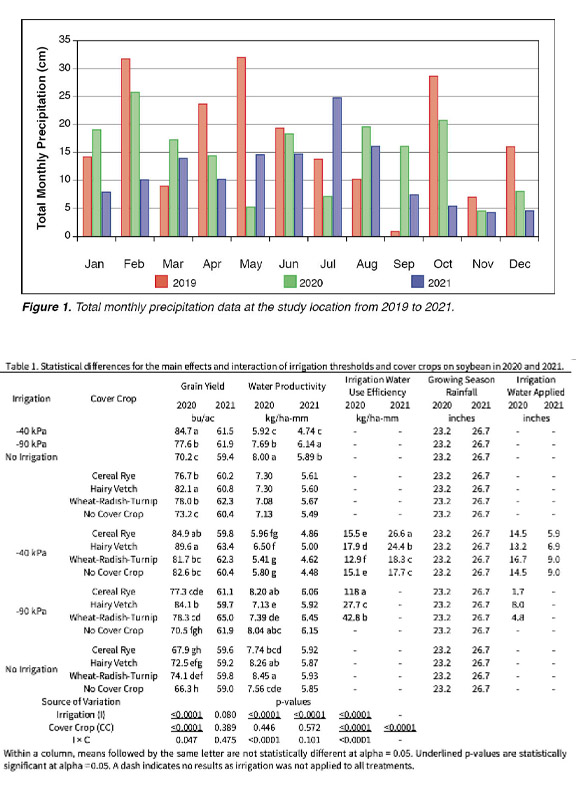Research Project
Evaluation of Winter Cover Crops and Irrigation Thresholds on a Subsequent Soybean Crop
Investigators: Dillon Russell, Gurpreet Kaur, Gurbir Singh
Date: 2021
Project Summary
Introduction
A steady decline in the Mississippi River Valley Alluvial Aquifer (MRVAA) has placed significant importance on developing better irrigation management strategies for decreasing water use while maintaining crop productivity. Previous research has been documented utilizing sensor-based irrigation scheduling on monoculture soybeans, but limited information is available on irrigation scheduling of soybean in combination with winter cover crops. Cover crops have shown to reduce irrigation water use and improve irrigation water use efficiency (IWUE) by increasing infiltration through the creation of root channels (Blanco-Canqui et al., 2015), and soil water holding capacity through residue decomposition (Irmak, 2020). The decomposed cover crop residues then act as a mulch, which aids in retaining residual soil moisture (Sullivan et al., 1991). Combining these cover crop benefits with a more conservative irrigation threshold for the subsequent soybean crop could be key to maximizing productivity. Therefore, the objective of this study was to determine if combinations of winter cover crops and irrigation scheduling thresholds could improve soybean yield, water productivity, and IWUE in the Mississippi Delta.
Materials and Methods
A field experiment was conducted at the National Center for Alluvial Aquifer Research in Leland, MS from 2019 to 2021. The soil classification for the experimental field was a Comirrigation merce silty clay loam soil (Fine-silty, mixed, superactive, nonacid, thermic Fluvaquentic Endoaquepts). The experiment was designed as a randomized complete block with four replications. Each replication included 12 four-row plots (each 13 ft × 100 ft) on 40” row spacing. Treatments in this study included combinations of winter cover crops (no cover crop, cereal rye, hairy vetch, and wheat-radish-turnip mix) and irrigation scheduling thresholds (no irrigation, -40 kPa sensor threshold, and -90 kPa sensor threshold). Cover crops were broadcasted by hand (simulating a fly-on application) into standing soybean at R6.5 growth stage and chemically terminated in the spring before soybean planting. The seeding rate for the cereal rye and hairy vetch were 60 lb/ac and 20 lb/ ac, respectively. The seeding rate for the mix included 40 lb/ac wheat, 4 lb/ac radish, and 2 lb/ac turnip. The soybean variety selected for this study was Asgrow 46X6 in year one and Asgrow 43X0 in year two, and the seeding rate for both years was 120,000 seeds/ac. Data collection included soybean yield, water productivity (yield divided by the sum of rainfall and irrigation), and irrigation water use efficiency (yield divided by irrigation). Rainfall data to calculate water productivity was collected from the National Weather Service’s Cooperative Observing Station located in Stoneville, MS (Figure 1).
Results and Discussion
In the first year of the experiment, soybean yield was at least 4.7 bu/ac greater in hairy vetch treatments under the -40 kPa irrigation threshold but was not different from cereal rye under the -40 kPa irrigation threshold. Water productivity in the first year was at least 2.3% higher in wheat-radish-turnip mix treatments under no irrigation but was not different from hairy vetch under no irrigation as well as cereal rye and no cover crop under the -90 kPa irrigation threshold. All irrigated treatments besides no cover crop under the -90 kPa irrigation threshold received irrigation water in year one, and among those treatments, cereal rye under the -90 kPa irrigation threshold had at least 75.2 kg/ha-mm higher IWUE compared to all other irrigated treatments. In year two, no differences were observed pertaining to soybean yield, but differences from the main effects of irrigation thresholds were observed for water productivity. Additionally, water productivity was highest under the -90 kPa irrigation threshold, which was at least 4% higher than the other irrigation treatments. Lastly, only -40 kPa irrigation threshold treatments received irrigation in 2021. Among those treatments, cereal rye contained at least 9% higher IWUE compared to the other cover crop treatments (Table 1).
Conclusion
In the first year of this study, -40 kPa irrigation treatments had the highest soybean yield but had the lowest water productivity and IWUE. As for year two, soybean yield and water productivity were lower and similar across all treatment combinations, and IWUE was highest in cereal rye under the -40 kPa irrigation. Based on these results from two years, the recommended cover crop irrigation threshold combination for soybean production in the Mississippi Delta region would be cereal rye under the -90 kPa irrigation threshold.
References
Blanco-Canqui, H., Shaver, T. M., Lindquist, J. L., Shapiro, C. A., Elmore, R. W., Francis, C. A., & Hergert, G. W. (2015). Cover crops and ecosystem services: Insights from studies in temperate soils. Agronomy Journal, 107(6), 2449-2474.
Irmak, S. (2020). Long term UNL study examines impacts of cover crops on soil, water. https://crop watch.unl.edu/long-term unl study examines impacts cover crops soil water
Sullivan, P. G., Parrish, D. J., & Luna, J. M. (1991). Cover crop contributions to N supply and water conservation in corn production. American Journal of Alternative Agriculture. 6(3), 106-113.
Project Photos

- Topic:
- Cover Crops
- Irrigation
Find Research
By Crop Type
By Topic
Contact NCAAR
General Information
Kaye Sullivan
vfs23@msstate.edu
662.390.8510
F:662.390.8501
Showcase Demo
Drew Gholson, Coordinator
drew.gholson@msstate.edu
662.390.8505
Himmy Lo
himmy.lo@msstate.edu
662.390.8509

